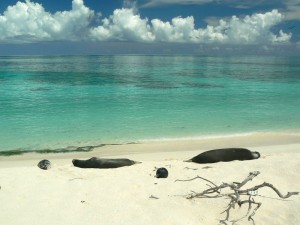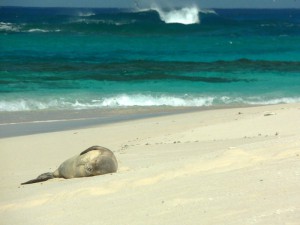Media Watch, NOAA press release, 8 June 2011

NOAA’s Fisheries Service has proposed 16 areas as critical habitat for the endangered Hawaiian monk seal under the Endangered Species Act (ESA), and is inviting public comment. The proposed revision includes expanding the 1988 critical habitat designation in the Northwestern Hawaiian Islands, and adding new areas throughout the main Hawaiian Islands.
In July 2008, NOAA Fisheries Service received a petition from non-governmental organizations to revise the Hawaiian monk seal critical habitat designation under the ESA. In June 2009, NOAA Fisheries Service released a 12-month finding, which is one step in the review process, announcing that the petition presented substantial scientific information indicating that a revision to the current critical habitat designation was warranted and announced its intention to move forward with a proposed rule.
Following this announcement, NOAA Fisheries Service convened a Critical Habitat Review Team of experts in the field of Hawaiian monk seal biology and management to evaluate critical habitat for the species.
“Monk seals are an important species for Hawaii, and such a valuable part of our ecosystem,” said Michael Tosatto, NOAA Fisheries Pacific Islands regional administrator. “This species faces a number of threats, and it’s imperative we ensure they have safe areas where they can rest and take care of their young.”
The team identified essential features for Hawaiian monk seal habitat, such as their need for reproduction, rearing of offspring, foraging, resting and habitat protected from disturbance. The team then identified areas throughout the Hawaii that met the criteria. NOAA Fisheries Service also considered the economic, national security and other relevant effects to the proposed areas.

Under the ESA, critical habitat is an area which may require special management or protections essential for the conservation of a listed species. Federal agencies must take precautions to insure that activities they fund, authorize or carry out do not destroy or adversely modify critical habitats.
Biologists estimate that only 1,160 Hawaiian monk seals exist, and are in danger of extinction because of their declining population in the Northwestern Hawaiian Islands.
Monk seals are wide ranging pinnipeds that require both marine and land habitats for reproduction, rearing, foraging and resting. However, unlike other well recognized pinnipeds that congregate in large numbers at rookeries, monk seals are considered a solitary species. They generally prefer to haul out in remote areas for reproduction and rest. The proposed revision to Hawaiian monk seal critical habitat allows NOAA Fisheries Service to incorporate new scientific information available regarding Hawaiian monk seals’ habitat use, and will allow for the conservation of those areas essential for Hawaiian monk seal survival and recovery.
NOAA’s Fisheries Service is accepting comments on the proposed revision through August 31, 2011. Dates, times and venues for public hearings will be available on our website at: www.fpir.noaa.gov. NOAA’s Fisheries Service will review comments and issue a final rule, expected by June 2, 2012.
To submit comments on the proposed critical habitat revision for the Hawaiian monk seal, use any of the following methods:
- Submit comments online via the Federal eRulemaking Portal at http://www.regulations.gov.
- Mail or hand deliver written comments to:
Regulatory Branch Chief
Protected Resources Division
NMFS Pacific Islands Region
1601 Kapiolani Blvd., Suite 1110
Honolulu, HI 96814
Attn: Proposed Critical Habitat Revision for the Hawaiian monk seal

what is the difference of the monk seal being protected (as of now) and having a critical habitat for the monk seal.